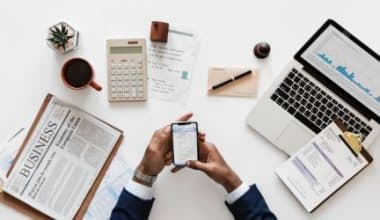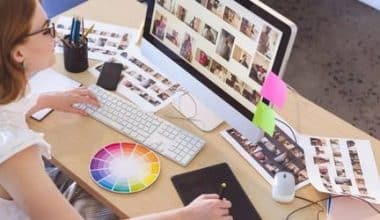If you’re interested in pursuing a career as a freelance graphic designer, there’s never been a better time to get started. With the rise of digital technology and the internet, the demand for graphic design work has skyrocketed. As a Freelance Graphic Designer, you have the opportunity to work from home and enjoy the flexibility that comes with it. However, it is important to remember that your work and salary are still dependent on the quality of your output as a freelance graphic designer, so it’s crucial to have a well-crafted resume that showcases your skills and experience in the field.
When it comes to work, be sure to establish clear boundaries and routines to ensure productivity and success. However, breaking into this competitive field can be challenging, and it can be difficult to know where to start. That’s why we’re here to offer some hints to help you navigate the world of freelance graphic design and achieve success.
What is Freelance Graphic Designer?
A Freelance Graphic Designer is a professional who creates visual content for various purposes, such as marketing, advertising, branding, and communication. They work on a project-by-project basis for different clients and often have the flexibility to work from home or remotely. Freelance graphic designers use their artistic skills, creativity, and technical expertise to produce designs that effectively communicate a message or idea to the target audience. They may work on a variety of design projects, including logos, websites, packaging, social media graphics, and more. However, freelance graphic designers typically have a strong portfolio showcasing their work, and they may work independently or as part of a team.
How Much Do Freelance Graphic Designers Charge?
Determining the appropriate fee for a project can be a tricky process for freelance graphic designers. It’s important to consider the amount of time and effort that will be required to complete the project, as well as the value that the design will bring to the client. Some designers may also charge a higher rate for more complex projects or those with tighter deadlines. Others may offer discounted rates for ongoing projects or for clients with whom they have a long-standing relationship.
In addition to the factors mentioned above, location can also play a role in the amount that freelance graphic designers charge. Those working in larger cities or areas with a higher cost of living may also charge more to account for higher expenses. However, with the rise of remote work and the ability to work with clients from around the world, the location may be less of a factor than in the past.
Ultimately, the fee charged by a freelance graphic designer should be fair and reflective of the value that the design will bring to the client. Clear communication about pricing and expectations upfront can also help ensure that both parties are satisfied with the arrangement.
What Does a Freelance Graphic Designer Do?
The role of a freelance graphic designer is to create visual content for clients to convey their messages and promote their brand or product. This may include designing logos, brochures, websites, social media graphics, packaging, and more. The work of a freelance Graphic Designer often works on a project-by-project basis for various clients, and their salary is usually based on the quality of their output and the value that they bring to the client. Therefore, having a well-crafted resume that showcases freelance graphic designer skills and experience in the field is crucial for Freelance Graphic Designers to attract clients and secure projects.
One of the benefits of working as a freelance graphic designer is the flexibility to work from home. This also allows designers to set their own schedules and work in a comfortable environment that suits their needs. However, it’s important to maintain a strong work ethic and establish a routine that allows for productivity and success. Freelance graphic designers must also have excellent communication skills to work effectively with clients, understand their needs and requirements, and deliver work that meets their expectations.
In summary, the work of a freelance graphic designer involves creating visual content for clients, and their salary is often based on the quality of their output, to attract clients and secure projects, Freelance Graphic Designers must have a strong resume that showcases their skills and experience in the field. Additionally, having the flexibility to work from home provides a comfortable and productive environment for freelance graphic designers to deliver high-quality work.
How Can I Start as a Freelance Graphic Designer?
Starting a career as a freelance graphic designer requires more than just an eye for design. Here are some more detailed steps to help you get started:
#1. Develop Your Skills
There are several ways to learn the basics of graphic design, including by taking online courses or attending a formal graphic design program at a college or university. You can also practice and develop your skills by working on personal projects or taking on volunteer work.
#2. Build Your Portfolio
Your portfolio should showcase your skills and style as a designer. It should include a variety of projects that demonstrate your ability to work on different types of design projects. Keep your portfolio up-to-date with your latest work and refine it over time to reflect your growth as a designer.
#3. Establish Your Brand
As a freelance graphic designer, your personal brand is important. Your brand should reflect your design style and approach, as well as your values and personality. You can establish your brand by creating a logo, website, and social media presence that is consistent with your style.
#4. Network
Building relationships is key to success as a freelance graphic designer. Attend design events, join online design communities, and also reach out to potential clients to let them know about your services. Networking can also help you find new clients, connect with other designers, and learn about industry trends.
#5. Set Your Rates
Determining your pricing structure and rates for your services can be a challenge. Consider factors such as your level of experience, the complexity of the project, and the time required to complete it. Research industry standards and consult with other designers to help you set your rates.
#6. Market Your Services
Promote your services to potential clients through your website, social media, and other marketing channels. Also, use your portfolio to showcase your work and emphasize the value that you bring as a freelance graphic designer. You can also offer promotions or referral incentives to attract new clients.
Is It Worth It to Be a Freelance Graphic Designer?
Undoubtedly, there are many reasons why being a freelance graphic designer can be a great career choice. Here are some of the benefits that make it worth considering:
#1. Flexible Work Hours
One of the biggest advantages of working as a freelance graphic designer is the ability to set your own schedule. This allows you to work at times that are most convenient for you, whether it’s early in the morning or late at night. This flexibility can be especially valuable for those with other commitments, such as childcare or school.
#2. Work From Home
Freelance graphic designers have the luxury of working from anywhere with an internet connection. This eliminates the need for a daily commute and also allows you to work from the comfort of your own home. This can also be a great option for those who prefer a quieter work environment or want to avoid the expenses associated with working in an office.
#3. Higher Earnings Potential
Freelance graphic designers can potentially earn more than those working in traditional design jobs. This is because they have the ability to set their own rates and take on multiple projects simultaneously. With the right marketing strategy and a strong portfolio, freelance graphic designers can build a reputation that allows them to charge higher rates for their services.
#4. Creative Freedom
As a freelance graphic designer, you have the freedom to choose the projects you work on and the clients you work with. This means you can also focus on projects that are most interesting and rewarding to you, allowing you to express your creativity and work on projects that align with your personal values.
While there are certainly challenges associated with working as a freelance graphic designer, the benefits of flexible work hours, the ability to work from home, higher earnings potential, and creative freedom make it a great option for those seeking a dynamic and fulfilling career.
How Do I Start Freelancing?
Starting a career as a freelancer can be a rewarding opportunity, but it requires careful planning and preparation. To begin freelancing, you should first identify your area of expertise and create a portfolio website showcasing your best work. You should then determine the specific services you will offer and set your rates accordingly. Finding clients can be challenging, but you can leverage your network and use social media and online marketplaces to promote your services. Finally, it’s important to stay organized and professional, manage your finances effectively, and continue learning and growing as a freelancer.
What Skills Do You Need to Be a Freelance Graphic Designer?
To be a successful freelance graphic designer, you need a combination of technical and creative skills, as well as strong communication and business skills. Here are some key skills you’ll need:
#1. Graphic Design Software Proficiency
You should have proficiency in industry-standard graphic design software such as Adobe Creative Suite, Photoshop, and Illustrator.
#2. Creativity
You should have a strong sense of creativity and an eye for design to create visually appealing designs that effectively communicate the intended message.
#3. Attention to Detail
You should pay meticulous attention to detail to ensure that designs are accurate and error-free.
#4. Communication Skills
You should be able to communicate effectively with clients to understand their needs and communicate your design ideas.
#5. Time Management
You should have strong time management skills to meet deadlines and deliver high-quality work on time.
#6. Business Skills
You should have a basic understanding of business principles, including pricing, invoicing, and contracts, to effectively manage your freelance business.
#7. Adaptability
You should also be adaptable and able to work on a variety of projects, including those outside your comfort zone. By developing these skills and constantly learning and growing as a designer, you can become a successful freelance graphic designer.
FAQs
Do you need qualifications to be a freelance graphic designer?
Freelance graphic designers can succeed without degrees. If you can acquire enough clients from a strong portfolio through networking or self-promotion, you can use self-learning to improve your talents.
Do freelance graphic designers earn a living?
Many professional graphic designers work as full-time employees for companies, while others make good money as freelance graphic designers.
Is graphic design a good career for freelancers?
Freelance graphic design is an excellent way to earn money while maintaining complete control over your life and career. However, success in freelance graphic design requires more than just being a good graphic designer.
Related Articles
- FREELANCE MARKETING: Meaning what to do & Salary
- FREELANCE CONTRACT: Examples, Templates, and Writing Guide
- FREELANCE DIGITAL MARKETING: Meaning, Job Description & Salary
- SALARIED EMPLOYEE: What Is It, Hours of Work, Rules & Difference
- DOT REGULATIONS: Meaning, What You Should Know & New Regulations
- AMBASSADOR PROGRAM: Definitions, Examples & Best Programs
- WHAT IS CONSTANT CONTACT: How It Works, Examples & Difference






